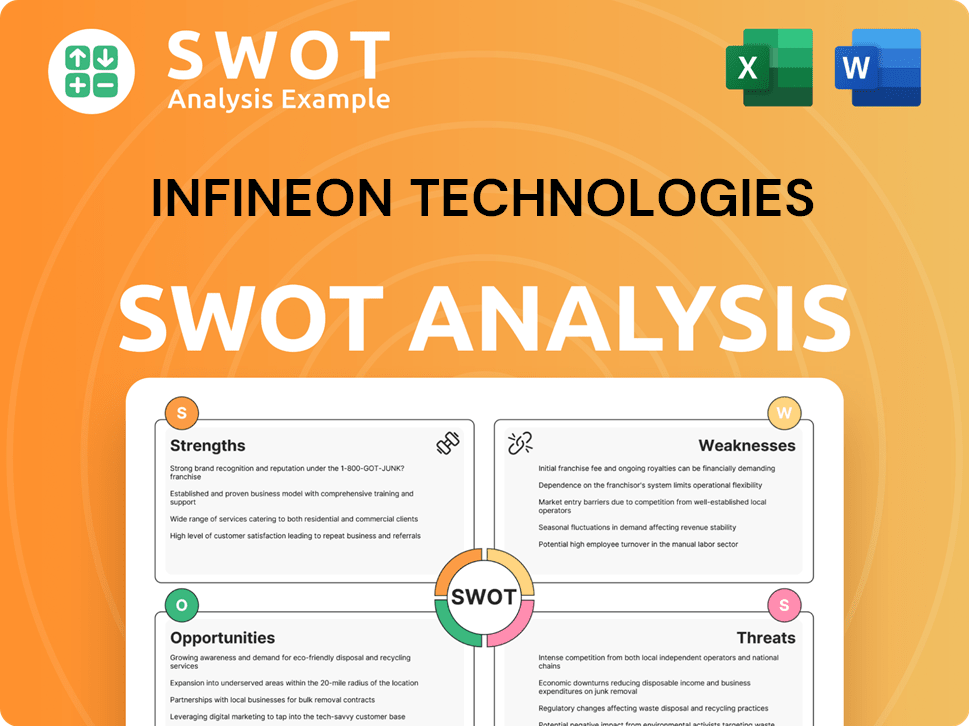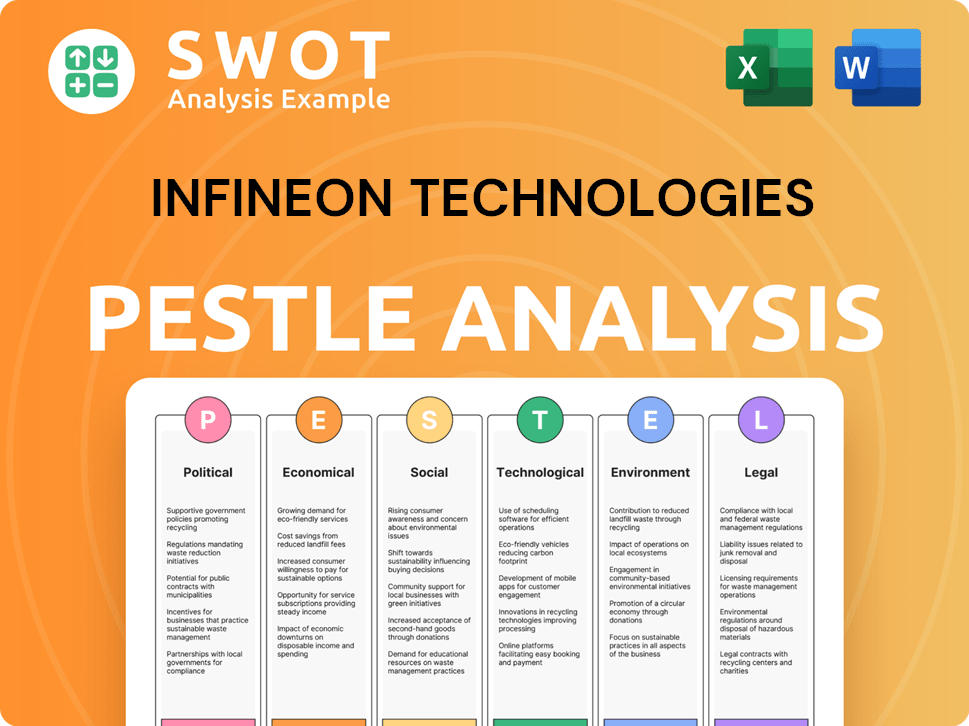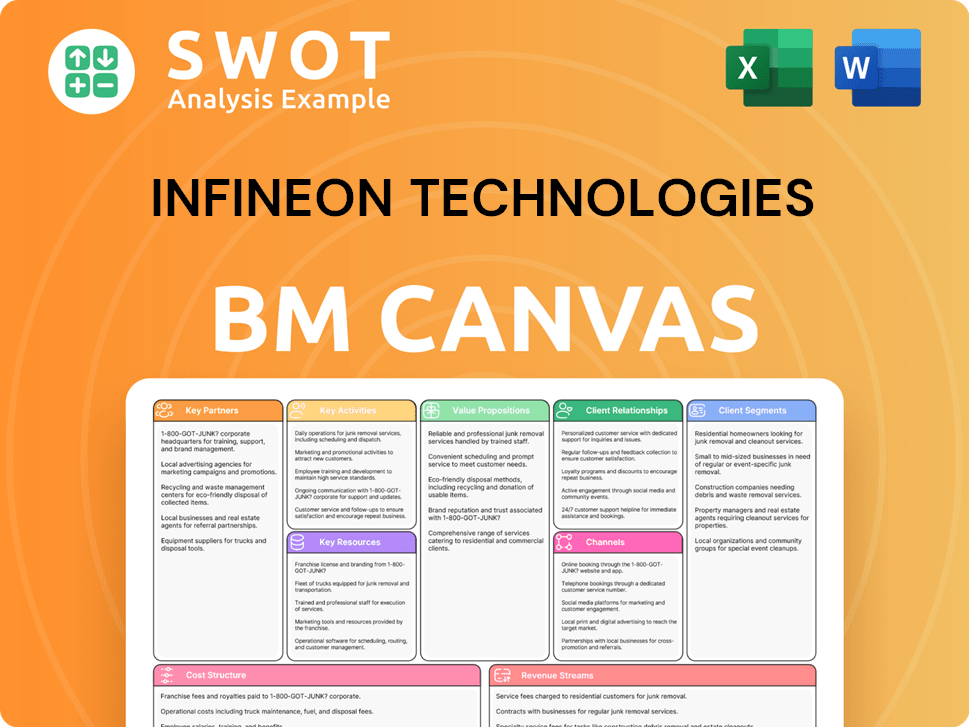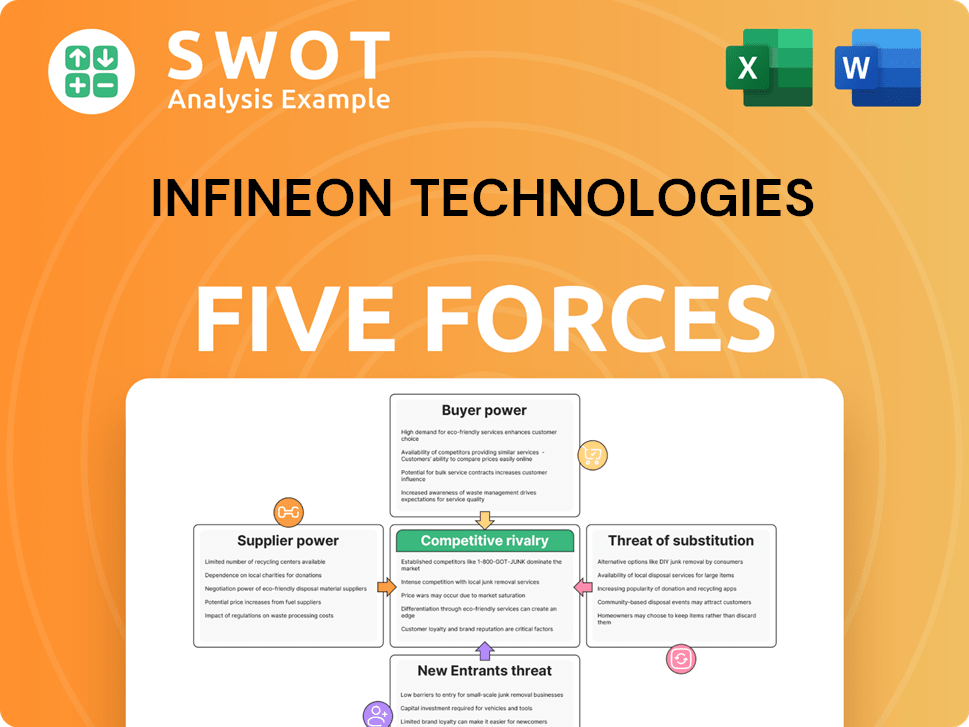Infineon Technologies Bundle
Who Buys Infineon's Tech?
Infineon Technologies, a powerhouse in the semiconductor industry, thrives on understanding its Infineon Technologies SWOT Analysis. But who exactly are the customers driving this global leader's success? This exploration dives deep into the customer demographics and Infineon Technologies target market, revealing the strategies behind its market dominance.

Understanding the Infineon customer profile is essential for investors, analysts, and anyone seeking to understand the company's growth trajectory. This Infineon market analysis will uncover the diverse segments Infineon serves, from automotive to industrial applications, and how it adapts to the ever-changing needs of the semiconductor industry customers. We'll also examine the company's target audience definition and strategic approaches to customer engagement.
Who Are Infineon Technologies’s Main Customers?
Understanding the customer demographics and target market of Infineon Technologies is crucial for grasping its business model. As a Business-to-Business (B2B) company, Infineon primarily serves other businesses rather than individual consumers. Its target audience is diverse, spanning several key industries that rely on its semiconductor solutions.
Infineon's Infineon customer profile is largely defined by the sectors it serves. These include automotive, industrial power control, power & sensor systems, and connected secure systems. Each segment has distinct needs and priorities, influencing Infineon's product development and market strategies. Analyzing these segments provides insight into Infineon's customer segmentation and its approach to meeting their specific demands.
The company's focus on these sectors has allowed it to establish a strong presence in the semiconductor industry customers market. The following sections will delve deeper into each of these segments, providing a comprehensive Infineon market analysis and highlighting the strategic importance of each customer group.
The automotive segment is a significant revenue driver for Infineon. It includes manufacturers of passenger cars, commercial vehicles, and two-wheelers. This segment demands high reliability, safety, and long-term supply. In the first quarter of fiscal year 2024, the automotive segment accounted for approximately 49% of Infineon's total revenue.
This segment serves manufacturers of industrial drives, renewable energy systems (solar inverters, wind turbines), and power supplies. Customers in this sector prioritize efficiency, performance, and cost-effectiveness. Infineon's solutions help these customers optimize energy usage and improve system reliability.
This division caters to consumer electronics (smartphones, home appliances), data centers, and various power management applications. Customers here seek compact designs, low power consumption, and high performance. Infineon's products are crucial for enabling the functionality and efficiency of these devices.
This segment focuses on digital security, including chip cards for payment and identification, and IoT applications. Customers in this area require robust security, reliable connectivity, and compliance with industry standards. Infineon's solutions support secure transactions and data protection.
Infineon's strategy involves focusing on high-growth, high-value segments like electromobility and renewable energy. This target audience definition is driven by global sustainability trends and the increasing demand for intelligent and energy-efficient solutions. The acquisition of Cypress Semiconductor in 2020 expanded its reach into microcontrollers and connectivity solutions.
- Automotive: Prioritizes reliability, safety, and long-term supply for advanced driver-assistance systems (ADAS) and electric powertrains.
- Industrial Power Control: Focuses on efficiency and performance for industrial drives and renewable energy systems.
- Power & Sensor Systems: Seeks compact designs and low power consumption for consumer electronics and data centers.
- Connected Secure Systems: Requires robust security and reliable connectivity for digital security and IoT applications.
Infineon Technologies SWOT Analysis
- Complete SWOT Breakdown
- Fully Customizable
- Editable in Excel & Word
- Professional Formatting
- Investor-Ready Format

What Do Infineon Technologies’s Customers Want?
Understanding the customer needs and preferences is crucial for success in the semiconductor industry. For Infineon Technologies, this involves a deep dive into the specific demands of its business-to-business (B2B) customers across various sectors. This customer-centric approach allows Infineon to tailor its products and services, ensuring they meet the evolving needs of its target market.
The Infineon customer profile is diverse, encompassing industries such as automotive, industrial applications, and consumer electronics. Each segment has unique requirements, driving specific purchasing behaviors and decision-making criteria. Factors like product performance, reliability, and cost-effectiveness are consistently prioritized across all customer segments.
Infineon market analysis reveals that the company's success hinges on its ability to address these diverse needs effectively. By focusing on these areas, Infineon maintains a strong position in the competitive semiconductor market. This approach is critical to retaining existing customers and attracting new ones.
In the automotive sector, customers demand semiconductors that can withstand harsh conditions and meet stringent safety standards. The electrification of vehicles drives strong demand for high-power semiconductors.
Customers in industrial applications seek solutions that enhance energy efficiency and improve system reliability. Infineon's industrial power control products are vital for applications like motor drives and renewable energy inverters.
Key purchasing behaviors revolve around product performance, reliability, quality, energy efficiency, cost-effectiveness, and security. These factors are consistently prioritized across all customer segments.
Psychological drivers for choosing Infineon often include trust in the brand's reputation for quality and innovation. The availability of comprehensive technical support and a stable supply chain are also crucial.
Infineon addresses common pain points such as design complexity and time-to-market pressures. The company provides extensive design-in support and software tools to accelerate customer development cycles.
Infineon tailors its marketing and product features by developing application-specific solutions. The company engages in co-creation with key customers to meet unique requirements.
Infineon's target market for automotive semiconductors includes manufacturers of electric vehicles (EVs) and hybrid vehicles. They require high-power semiconductors such as silicon carbide (SiC) and gallium nitride (GaN) power devices. The industrial automation sector is another key area, with customers seeking solutions to enhance energy efficiency, reduce operational costs, and improve system reliability. Brief History of Infineon Technologies provides further insights into the company's evolution and strategic focus.
Infineon's customer base values performance, reliability, and energy efficiency. Meeting these needs involves providing comprehensive technical support and ensuring a stable supply chain.
- Automotive: Robust and fault-tolerant semiconductors, high-power devices for EVs.
- Industrial: Solutions for energy efficiency, reduced operational costs, and improved system reliability.
- IoT: Secure connectivity solutions.
- Customer Support: Extensive design-in support, reference designs, and software tools.
Infineon Technologies PESTLE Analysis
- Covers All 6 PESTLE Categories
- No Research Needed – Save Hours of Work
- Built by Experts, Trusted by Consultants
- Instant Download, Ready to Use
- 100% Editable, Fully Customizable

Where does Infineon Technologies operate?
Infineon Technologies maintains a robust global presence, strategically positioned across Asia, Europe, and North America. This widespread reach allows the company to cater to diverse customer demographics and market demands. The company's success is significantly tied to its ability to understand and serve these varied regional markets effectively.
Asia, particularly China, is a crucial market for Infineon, driven by its extensive manufacturing capabilities and rising demand for electronics. Europe is another key region, benefiting from a strong automotive sector and a focus on renewable energy. North America also plays a significant role, especially in data centers, IoT, and advanced automotive applications, which are crucial for understanding the Infineon Technologies target market.
The company's approach involves adapting to regional preferences and requirements. This includes establishing local sales and support offices, customizing product specifications to meet local standards, and forming partnerships with local distributors and system integrators. This localization strategy is key to serving the Infineon customer profile effectively.
In the first quarter of fiscal year 2024, the Asia-Pacific region, excluding Japan, accounted for approximately 48% of Infineon's revenue. This highlights the region's significance in the company's overall financial performance. This strong presence is indicative of the company's strategic focus on this high-growth market.
Europe benefits from a robust automotive industry and investments in renewable energy, influencing product priorities. The company's focus on industrial automation and green energy solutions aligns with European market trends. This strategic alignment helps Infineon meet the specific needs of its European customers.
North America represents a substantial market, particularly for data centers, IoT, and advanced automotive applications. These sectors are key drivers of growth and innovation. Infineon's presence in North America is crucial for its long-term market strategy.
Infineon localizes its offerings by establishing regional sales and support offices. They also adapt product specifications to regional standards. Strategic partnerships with local distributors and system integrators are also key. These strategies ensure that the company can effectively serve its diverse customer base.
Infineon's market strategy includes strengthening its presence in emerging markets and reinforcing its position in established regions. The company's global manufacturing facilities in Europe, Asia, and the Americas support its ability to serve diverse markets efficiently. This geographic diversification helps mitigate supply chain risks. For a deeper understanding of how Infineon operates, including its revenue streams and business model, consider reading this article: Revenue Streams & Business Model of Infineon Technologies.
Infineon segments its customers based on industry, application, and geographic location. This allows for tailored product offerings and marketing strategies. Understanding these segments is critical for effective Infineon market analysis.
The company's target audience definition includes automotive manufacturers, industrial automation companies, and providers of renewable energy solutions. These industries drive demand for Infineon's semiconductor products. The company focuses on meeting their specific needs.
The automotive sector is a significant market, with demand driven by electric vehicles and advanced driver-assistance systems (ADAS). Infineon's power solutions and microcontrollers are crucial in this sector. This is a key area for Infineon's target market for automotive semiconductors.
Infineon serves the industrial automation market with products designed for efficiency and reliability. Its components are used in various applications, including robotics and factory automation. This is a key aspect of Infineon's customer base in industrial automation.
Power management solutions are essential for various applications, including consumer electronics and data centers. Infineon's products help optimize energy consumption and improve performance. This is a core area for Infineon's target market for power management.
Infineon targets the IoT market with solutions for connectivity, security, and sensing. These products are used in a wide range of devices. This is a growing segment within Infineon's target market for IoT devices.
Infineon Technologies Business Model Canvas
- Complete 9-Block Business Model Canvas
- Effortlessly Communicate Your Business Strategy
- Investor-Ready BMC Format
- 100% Editable and Customizable
- Clear and Structured Layout

How Does Infineon Technologies Win & Keep Customers?
Infineon Technologies, a key player in the semiconductor industry, employs a strategic approach to customer acquisition and retention, crucial for its success in the B2B market. Their strategies are tailored to engage with a diverse customer demographics, from large Original Equipment Manufacturers (OEMs) to smaller enterprises. This approach is supported by a blend of direct sales, distribution channels, and targeted marketing efforts.
The company focuses on building long-term relationships and providing excellent technical support to maintain customer loyalty. Understanding the Infineon customer profile and their specific needs allows them to tailor solutions effectively. This is achieved through a combination of high-quality products, responsive supply chains, and comprehensive after-sales service.
Infineon's approach demonstrates a deep understanding of its Infineon Technologies target market. By adapting to market trends and focusing on strategic customer engagement, they aim to enhance customer lifetime value and reduce churn, solidifying their position in the competitive semiconductor landscape.
Direct sales teams are vital for engaging with large OEMs and strategic accounts. This approach fosters in-depth technical collaborations, which are essential for developing tailored solutions. These collaborations lead to long-term partnerships, ensuring sustained business.
A global network of distributors expands the customer base, reaching smaller and medium-sized enterprises. Distributors provide localized support and logistics, crucial for serving a wide range of customers. This channel is essential for broad market penetration.
Marketing efforts include digital platforms, industry trade shows, and technical conferences. These channels showcase innovations and engage potential customers. Digital marketing focuses on content, webinars, and online product catalogs.
Customer retention relies on high-quality products, excellent technical support, and strong account management. They focus on consistent product performance and a responsive supply chain. After-sales service is also paramount for ensuring customer satisfaction.
Infineon's customer acquisition and retention strategies are continually evolving. They are adapting to market trends, such as the increasing demand for integrated solutions and software support. For example, the automotive sector remains a significant area of focus. In 2023, the automotive segment accounted for approximately 48% of Infineon's revenue. This highlights the importance of catering to the specific needs of this industry and the broader semiconductor industry customers. Furthermore, the company's emphasis on co-development initiatives and strategic customer engagement contributes to customer lifetime value and reduces churn. For more insights into the competitive environment, you can explore the Competitors Landscape of Infineon Technologies.
Infineon serves key industries, including automotive, industrial power control, power and sensor systems, and connected security systems. These segments are essential for Infineon's market analysis and strategic focus. The automotive sector is a major driver, with significant investments in electromobility.
Customer segmentation includes OEMs, Tier 1 suppliers, and smaller enterprises. They tailor their approach to meet the diverse needs of each segment. Understanding these segments is crucial for effective targeting and resource allocation.
Digital marketing focuses on content marketing, technical webinars, and online product catalogs. These resources educate engineers and decision-makers. Social media, particularly LinkedIn, is used for corporate branding and thought leadership.
After-sales service includes technical assistance, application support, and product lifecycle management. These services are essential for ensuring customer satisfaction. This approach fosters repeat business and long-term relationships.
Strategic partnerships and co-development initiatives enhance customer lifetime value. They reduce churn by embedding solutions within customer products and ecosystems. These partnerships drive innovation and mutual growth.
A responsive and reliable supply chain is critical for customer retention. Ensuring timely delivery and product availability is a key aspect of customer satisfaction. This reliability builds trust and enhances customer loyalty.
Infineon Technologies Porter's Five Forces Analysis
- Covers All 5 Competitive Forces in Detail
- Structured for Consultants, Students, and Founders
- 100% Editable in Microsoft Word & Excel
- Instant Digital Download – Use Immediately
- Compatible with Mac & PC – Fully Unlocked

Related Blogs
- What are Mission Vision & Core Values of Infineon Technologies Company?
- What is Competitive Landscape of Infineon Technologies Company?
- What is Growth Strategy and Future Prospects of Infineon Technologies Company?
- How Does Infineon Technologies Company Work?
- What is Sales and Marketing Strategy of Infineon Technologies Company?
- What is Brief History of Infineon Technologies Company?
- Who Owns Infineon Technologies Company?
Disclaimer
All information, articles, and product details provided on this website are for general informational and educational purposes only. We do not claim any ownership over, nor do we intend to infringe upon, any trademarks, copyrights, logos, brand names, or other intellectual property mentioned or depicted on this site. Such intellectual property remains the property of its respective owners, and any references here are made solely for identification or informational purposes, without implying any affiliation, endorsement, or partnership.
We make no representations or warranties, express or implied, regarding the accuracy, completeness, or suitability of any content or products presented. Nothing on this website should be construed as legal, tax, investment, financial, medical, or other professional advice. In addition, no part of this site—including articles or product references—constitutes a solicitation, recommendation, endorsement, advertisement, or offer to buy or sell any securities, franchises, or other financial instruments, particularly in jurisdictions where such activity would be unlawful.
All content is of a general nature and may not address the specific circumstances of any individual or entity. It is not a substitute for professional advice or services. Any actions you take based on the information provided here are strictly at your own risk. You accept full responsibility for any decisions or outcomes arising from your use of this website and agree to release us from any liability in connection with your use of, or reliance upon, the content or products found herein.